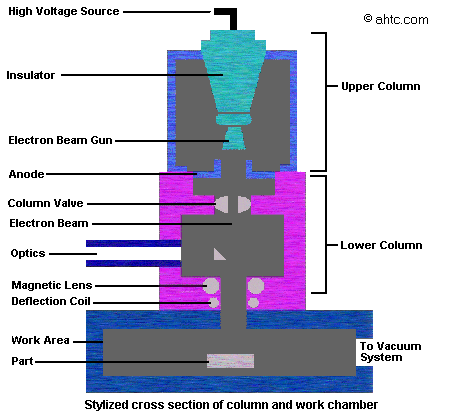The Electron Beam (EB) Welding Process
At Andrews Hi-Tec Corporation, we utilize the advanced Electron Beam (EB) Welding process, which offers unparalleled precision, strength, and quality in metal joining. Here’s a breakdown of how this cutting-edge process works:
 |
-> Anode |
How the Electron Beam is Generated
Electron Beam Welding relies on a high-energy stream of electrons to fuse materials. The process begins with electron generation inside the electron beam gun:
1- Electrons are produced by heating a filament within the electron beam gun.
2- Due to the gun’s special design, the electrons are shaped into a concentrated beam.
3- This beam travels through several critical components:
• Anode
• Column Valve
• Magnetic Lens
• Deflection Coil
After passing through these elements, the beam is directed into the work area to weld the part.
High-Speed Precision
The stream of high-energy electrons is accelerated to approximately two-thirds the speed of light—around 117,000 miles per second. When the electrons collide with the metal surface, their kinetic energy is converted into thermal energy (heat), causing the metal to melt and fuse, resulting in a precise and durable weld.
Welding Process Overview
The electron beam welding process is conducted in a vacuum chamber to prevent oxidation and contamination. Here’s a step-by-step overview:
1- Part Loading: The operator places the part (or multiple parts) into a fixture mounted to the base table inside the vacuum chamber.
2- Vacuum Creation: The chamber is evacuated to a vacuum level of approximately 10⁻⁴ mm Hg, ensuring an environment free from air molecules that could scatter the electron beam.
3- Beam Activation: The operator initiates the electron stream and uses it to fine-tune settings on the meters. Once the parameters are set, the beam is directed onto the part to begin the weld.
4- Welding: The high-energy electron beam fuses the parts with extreme precision, ensuring a strong and reliable weld. Operators can monitor the process directly through optics or remotely via a CCTV system.
5- Chamber Venting: Once welding is complete, the chamber is vented to return to atmospheric pressure, and the operator removes the welded part.
Versatility and Precision
The electron beam welding process excels at welding a wide range of materials and thicknesses. Whether you’re working with thin foils or thick plates, the precision of EB welding ensures high-quality results across nearly all metal alloys. This includes difficult-to-weld refractory materials such as columbium and tantalum, which can be welded without the risk of oxidation due to the controlled vacuum environment.
Why Choose Electron Beam Welding?
The advantages of EB welding are numerous—ranging from its ability to handle complex geometries to minimal heat distortion and the capability to weld dissimilar materials. For a detailed overview of these benefits, please visit our ‘ADVANTAGES‘ page.

